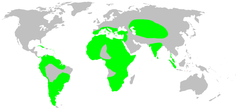Palpimanidae
| Palpimanidae | |
|---|---|
 | |
| Male Sarascelis chaperi | |
| Scientific classification | |
| Kingdom: | Animalia |
| Phylum: | Arthropoda |
| Subphylum: | Chelicerata |
| Class: | Arachnida |
| Order: | Araneae |
| Infraorder: | Araneomorphae |
| Family: | Palpimanidae Thorell, 1870 |
| Genera | |
|
See text. | |
| Diversity | |
| 15 genera, 127 species | |
 | |


Palpimanidae is a family of spiders, known as palp-footed spiders. The family is fairly small; it includes about 130 described species of ground-dwelling spider in 15 genera.
Description
The most obvious features of the Palpimanidae are the front legs, which are disproportionately powerful and heavily sclerotised. The abdomen is round to oval, evenly sprinkled with short straight hairs that in some species are sufficiently dense to form a close-fitting coat, though most species look nearly smooth. Usually the cephalothorax is somewhat less obviously hairy. The abdomen is evenly rounded without conspicuous sculpting, and in many species is elongated into an olive shape twice as long as the cephalothorax, giving the spider a vaguely torpedo-shaped appearance. Instead of having six spinnerets like most spiders, the Palpimanidae have only two. Colour patterns generally are subdued and simple. A few genera, such as Diaphorocellus have light patches on a dark abdomen. Most others are brownish or reddish to dark in general colour, but as a rule the cephalothorax is more heavily sclerotised and darker than the abdomen, as well as glossier. There are eight eyes in two rows of four, but in some species the outer anterior and posterior eyes are close together, which has caused some people to think there are just six eyes. In some species the chelicerae have stimulatory organs, microscopic ridges, with pegs that scrape over them when they rub the chelicerae together. The probable function is to signal to each other in mating, though it might have some defensive role as well.[1]
Biology
The behaviour of the Palpimanidae is in general poorly investigated. All species produce ecribellate silk.[2] They certainly are ground dwellers and do not spin webs, though they many do spin shelters for themselves in holes or under rocks. Palpimanus gibbulus at least, lives in leaf litter or under stones in dry soils. Many or most species go wandering at night, either hunting or seeking mates. They generally keep their very strong first legs held up in front of themselves while walking slowly at night,[1] and on encountering possible prey they may feel it gently before grabbing it very rapidly and powerfully, as shown in some on-line video material.
Distribution
In general species in this family are widely distributed throughout the tropical and subtropical regions of the world, but are absent from Australia. Generally they are not common and there is a high degree of endemism.[1] A few species also occur in the Mediterranean and one in Uzbekistan.
Taxonomy
The genera have been distributed as follows into three subfamilies. [3]
- Chediminae
- Badia Roewer, 1961 — Senegal
- Boagrius Simon, 1893 — Africa, South Asia
- Chedima Simon, 1873 — Morocco
- Diaphorocellus Simon, 1893 — Africa
- Hybosida Simon, 1898 — Africa, Seychelles
- Sarascelis Simon, 1887 — Africa, India, Malaysia
- Scelidocteus Simon, 1907 — Africa
- Scelidomachus Pocock, 1899 — Socotra
- Steriphopus Simon, 1887 — Myanmar, Seychelles, Sri Lanka
- Otiothopinae Platnick, 1999
- Anisaedus Simon, 1893 — South America, Africa
- Fernandezina Birabén, 1951 — South America
- Notiothops Platnick, Grismado & Ramírez, 1999 — Chile
- Otiothops MacLeay, 1839 — South America, Cuba
- Palpimaninae Thorell, 1870
- Ikuma Lawrence, 1938 — Namibia
- Palpimanus Dufour, 1820 — Mediterranean, Africa, South America, India, Uzbekistan
See also
References
- 1 2 3 Dippenaar-Schoeman, Ansie. Field Guide to the Spiders of South Africa. 2014 LAPA Publishers ISBN 978-0-7993-6018-9
- ↑ Griswold et al. 1999
- ↑ Joel Hallan Biology Catalog
- Platnick, N.I. (1975): A revision of the palpimanid spiders of the new subfamily Otiothopinae (Araneae, Palpimandae). American Museum novitates 2562. PDF - Abstract
- Griswold, C.E., Coddington, J.A., Platnick, N.I. and Forster, R.R. (1999): Towards a Phylogeny of Entelegyne Spiders (Araneae, Araneomorphae, Entelegynae). Journal of Arachnology 27: 53-63. PDF
- Platnick, Norman I. (2007): The world spider catalog, version 8.0. American Museum of Natural History.
Further reading
- Platnick, N.I. (1978): A new Otiothops from Colombia (Araneae, Palpimanidae). J. Arachnol. 5: 179-180. PDF (O. kochalkai)
- Platnick, N.I. (1985): On the Chilean spiders of the family Palpimanidae (Arachnida, Araneae). J. Arachnol. 13: 399-400. PDF
- Platnick, N.I., Grismado, C.J. & Ramírez, M.J. (1999): On the genera of the spider subfamily Otiothopinae (Araneae, Palpimanidae). American Museum novitates 3257. PDF - Abstract
- Grismado, C.J. (2002): Palpimanid spiders from Guyana: New species of the genera Fernandezina and Otiothops (Araneae, Palpimanidae, Otiothopinae). Iheringia, Sér. Zool. 92: 3. PDF - HTML - doi:10.1590/S0073-47212002000300002
External links
| Wikispecies has information related to: Palpimanidae |
| Wikimedia Commons has media related to Palpimanidae. |